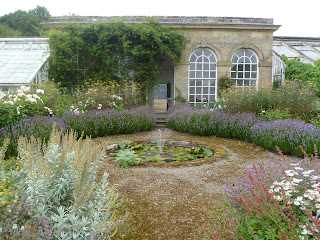After this introduction we were allowed to wander around in the house and visit the rooms opened to the public. Sir James and Lady Graham stuck around and were very willing to answer any questions. I told Lady Graham of my interest in the link of Norton Conyers with Charlotte Brontë and she showed me the library which had been restored and re-furnished with items that Charlotte would have seen when visiting. She pointed out a few of these items (such as a pair of globes, a cabinet piano in the window-bay, painting equipment, the bookcases – most of which are locked apart from one triangular bookcase in a corner which contains “everything that could be needed in the way of elementary works” as described in Jane Eyre). The room was re-furnished in accordance with the description of Mr. Rochester’s study, which was used in the novel by Jane Eyre as a classroom for Mr. Rochester’s ward Adele Varens.
 |
| The Library |
Apart from the Library the rooms open to the public are: the Dining Room, the Hall (where we started the tour), the Parlour (all on the ground floor), the main oak staircase, and on the first floor: the landing (with the “secret” door), the Passage, the Best Bedroom (with a reproduction of a unique wallpaper design found in an attic cupboard) and King James’s Room (where King James II and his wife stayed during their visit in 1679- still displaying the traditional bed they are supposed to have used). Throughout the house, in all rooms open to the public, you can see a beautiful collection of family portraits and other paintings related to the house and its inhabitants, magnificent old furniture, beautiful 18th century plaster ceilings and many other valuable treasures and fine art work.
 |
| The landing with (behind me in the wood panelling) the secret door to the attic |
 |
| The main oak stair case |
 |
| The Parlour |
 |
| King James's room |
 |
| The Dining room |
The house is a real marvel, so lovingly and passionately restored to its original grandeur, with great attention to detail, but there is still a lot of work to be done. I was in awe when I finished the tour. The house has indeed a special friendly, welcoming atmosphere, which according to Sir James “results from its having belonged to the same family for 392 years”. Personally I think it is also the result of the passion and dedication with which the current owners have restored and taken care of the house. You can definitely see and feel this passion in every room you visit. And some hard work has gone into the restoration, for sure! Thanks are due to Sir James and Lady Graham for saving this fascinating historic gem for generations to come.
 |
| The Stable block |
 |
| The Garden in full bloom |
 |
| The Garden in full bloom |
 |
| The Orangery |
We still had to visit the walled garden and the stable block which is also a Grade II-listed building (as is the house). The walled garden is five minutes’ walk from the house. It covers over three acres and was designed in the mid-18th century. It still retains the essential features of the original design: two paths meeting at the central feature (the Orangery), flanked by greenhouses, with a small ornamental pond before it and colourful flower and herbaceous borders everywhere in the garden. It gives the visitor this feeling of utter tranquility, which we all need once in a while in our busy lives!
What a perfect way of ending this extraordinary visit!
And, for those unmarried souls amongst us, a special message: Reader, you can marry here!
(Norton Conyers is indeed a wonderful venue for weddings and other celebrations/events!)
Marina Saegerman
27 August 2016

No comments:
Post a Comment